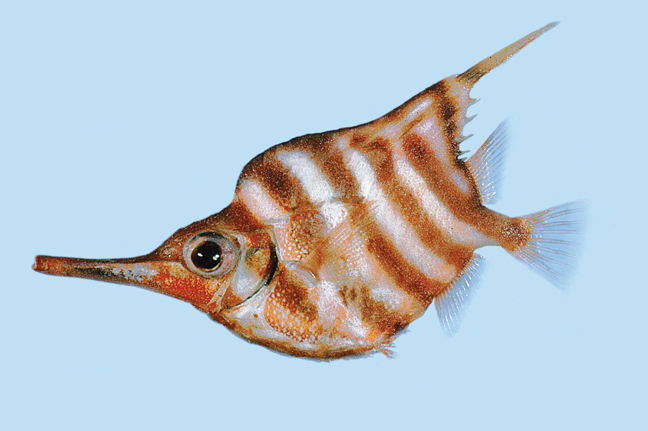Banded Bellowsfish, Centriscops humerosus (Richardson 1846)

Orange form of the Banded Bellowsfish, Centriscops humerosus. Source: Ken Graham. License: All rights reserved
The Banded Bellowsfish is the only species in the genus Centriscops. Juveniles look quite different from the adults, and until recently, were thought to be a different species.
Banded Bellowsfish, Centriscops humerosus (Richardson 1846)
More Info
|
Distribution |
Circumglobal in temperate waters of the southern hemisphere, including southern Australia, New Zealand, South America and South Africa; adults benthic or benthopelagic, juveniles pelagic on the continental shelf and slope at 350–1000 m (300–700 m in Australian waters). |
|
Features |
Meristic counts: Dorsal fin VI–VII, 16-19; Anal fin 17–21; Pectoral fin 16–18; Pelvic fin I, 5; Caudal fin 9. Head and body: Body very deep, almost circular, highly compressed, depth 38–62% SL; upper and lower body profiles asymmetrical; nape of small specimens with an angular hump and a pronounced rounded hump in adults; snout long, tubular, length 26–33% SL; upper edge of orbits strongly serrated in large specimens; nape with angular hump at small sizes and pronounced rounded hump in large adults, Fins: Dorsal‑fin spines set into a dorsoposteriorly skewed hump, 2nd dorsal fin enlarged, 40–47% SL; pelvic fins small. Scales: Four well-developed bony plates present at the shoulder region, bristle-like spines absent. Scales modified into coarse denticles, covering almost all of head and body. |
|
Size |
To 28 cm SL |
|
Colour |
Whitish with up to 5 oblique dark-edged orange bands, bands uniformly orange in very large adults; dorsal, anal and caudal fins with dusky to orange hue distally; juveniles bluish grey with colourless fins, bands absent. |
|
Feeding |
Carnivores, feeding on benthic invertebrates including crustaceans, bryozoans, polychaetes, pteropod molluscs and occasionally fish such as the lanternfish Lampanyctodes hectoris. |
|
Biology |
Oviparous (eggs hatch and develop outside the body) with planktonic eggs and larvae. |
|
Fisheries |
Commonly discarded as by-catch in commercial trawl fisheries and in the scalefish trap sector of the gillnet, hook and trap fishery. Frequently taken near 600 m with commercial catches of Ling, Gemfish and King Dory. |
|
Conservation |
Not evaluated. |
|
Remarks |
Juveniles have smaller eyes, a smaller hump on the nape and a very different colour pattern from adults. Until recently, juveniles and adults were thought to be separate species. |
|
Etymology |
Centriscus is from the Latin centrum, meaning point, prickle, spur, in reference to the large second dorsal-fin spine. They are commonly called Bellowsfish, as their shape resembles an old fire bellows. |
|
Species Citation |
Centriscops humerosus Richardson 1846, Ichthyology of the voyage of H. M. S. Erebus & Terror 2(2): 56, Pl. 34 (figs. 5-6), South Australia. |
|
Author |
Dianne J. Bray & Vanessa J. Thompson |
Banded Bellowsfish, Centriscops humerosus (Richardson 1846)
References
Baker, J.L. 2007. Status of Marine Species at Risk in South Australia: Technical Report – Bony and Cartilaginous Fish. Electronic book for the South Australian working group for marine species of conservation concern. Department for Environment and Heritage, S.A.; Marine and Coastal Community Network, S.A. Branch; Reef Watch, S.A., and Threatened Species Network.
Blaber, S.J.M. & Bulman, C.M. 1987. Diets of fishes of the upper continental slope of eastern Tasmania: content, calorific values, dietary overlap and trophic relationships. Marine Biology 95(3): 345-356.
Duhamel, G. 1995. Révision des genres Centriscops et Notopogon, Macroramphosidae des zones subtropicale et tempérée de l'hémisphère sud. Cybium 19(3): 261-303.
Heemstra P.C. 1986. Macroramphosidae, in Smith M.M. & Heemstra P.C. (eds) Smiths’ Sea Fishes. Macmillian South Africa Pty Ltd.
Kuiter, R.H. 1993. Coastal fishes of South-Eastern Australia. Crawford House Press Pty Ltd Bathurst NSW Australia
Kuiter, R.H. 2009. Seahorses, pipefishes and their relatives. Aquatic Photographics, Seaford, Australia., 333pp.
Paxton, J.R., J.E. Gates & D.F. Hoese. 2006. Gasterosteiformes, In Hoese, D.F., D.J. Bray, J.R. Paxton, G.R. Allen, Beesley, P.L. & A. Wells (Eds). Zoological catalogue of Australia. Volume 35 Fishes. ABRS & CSIRO Publishing, Australia. Part 2.



